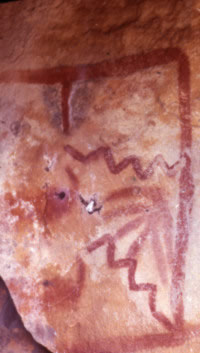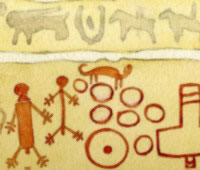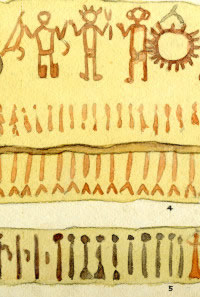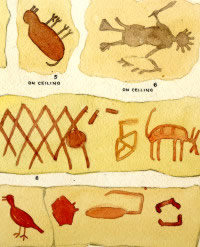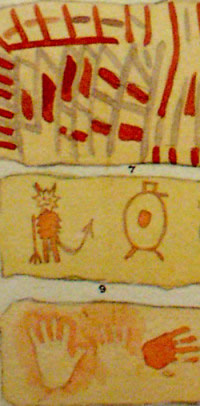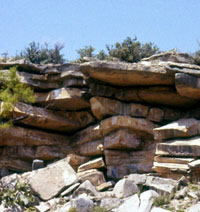
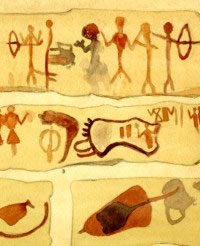
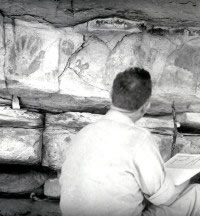
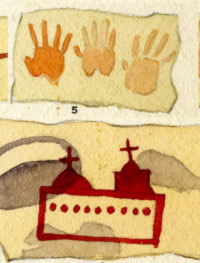
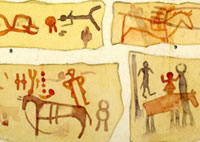
Paint Rock Pictographs
On a bluff along the banks of the Concho River in west-central Texas lies the most remarkable rock art site on the Edwards Plateau. The Paint Rock pictographs number over 1,500 and cover nearly a half-mile of a limestone cliff face a short distance upstream from the town of Paint Rock. In tones of red, orange, yellow, white, and black, native artists painted animals, such as buffalo and deer, human figures, some appearing to be clasping hands in a dance or ritual, and a kaleidoscope of geometric designs on the high bluff. Some left their handprints, perhaps as a way of signing their work or merely indicating that they had been there.
The Paint Rock site is unusual in that it is one of only a handful of sites in central and northwest Texas. Rock art is much more prevalent, more ancient as a rule, and better preserved in the Lower Pecos and Trans-Pecos areas. While it is impossible to know the date of the earliest pictographs at Paint Rock, archeological investigations at the site have recovered arrow points and sherds of earthenware pottery. These artifacts indicate that the site was used at least as early as the Toyah period (ca. A.D. 1300 – 1650), and are reflected in drawings of hunters carrying bows and arrows. Paintings of horses and a church demonstrate that use of the site by native groups continued after contact with the Spanish.
The Paint Rock pictographs (41CC1) were first documented in the 1930s by A.T. Jackson, one of the earliest Texas archeologists. Rock art illustrator Forrest Kirkland visited the site in 1935 to document the paintings. After his visit, he estimated that at least a quarter of the pictographs had been destroyed by vandals and the forces of nature. Fortunately, the owners of the land on which the site is located have been particularly vigilant in protecting the site from further vandalizing.
A painting of a rectangular structure with two crosses atop it (see plate 7, No.6) is believed by many to represent the San Saba Mission, the remains of which have been uncovered near present-day Menard some 50 miles to the south. Established by the Spanish in 1757 for the Lipan Apache, some of these images, including a devil figure (Plate 107,No.9) may be attributable to that tribe. The Paint Rock area was a hotbed of conflict between the Lipan and Comanche, the latter of whom also may have left their signs on the bluff, along with any number of other Indians who traveled through the valley in historic times.
A few researchers have interpreted some of the paintings of human figures (perhaps holding scalps) to represent abductions of early Anglo settlers in the area. Though there is no shortage of interpretations of these and other pictographs at Paint Rock, there is no way to know the true meaning the pictographs held for those who painted them.
The images shown here are watercolor copies of the rock art, painstakingly recorded by Kirkland. As he put it, "Here was a veritable gallery of primitive art at the mercy of the elements and handful of destructive people." His watercolors, along with the hundreds he made of rock art in the western regions of the state, have preserved native paintings which, in many cases, would have been lost forever.
For more information on Kirkland and his renderings of Lower Pecos art, see the Artistic Expressions exhibit. Kirkland's work is featured also in The Rock Art of Texas Indians, University of Texas Press, 1967,written by UT-Austin anthropologist W. W. Newcomb.) Additional photographs of rock art of native peoples is featured in the Lower Pecos exhibit.
